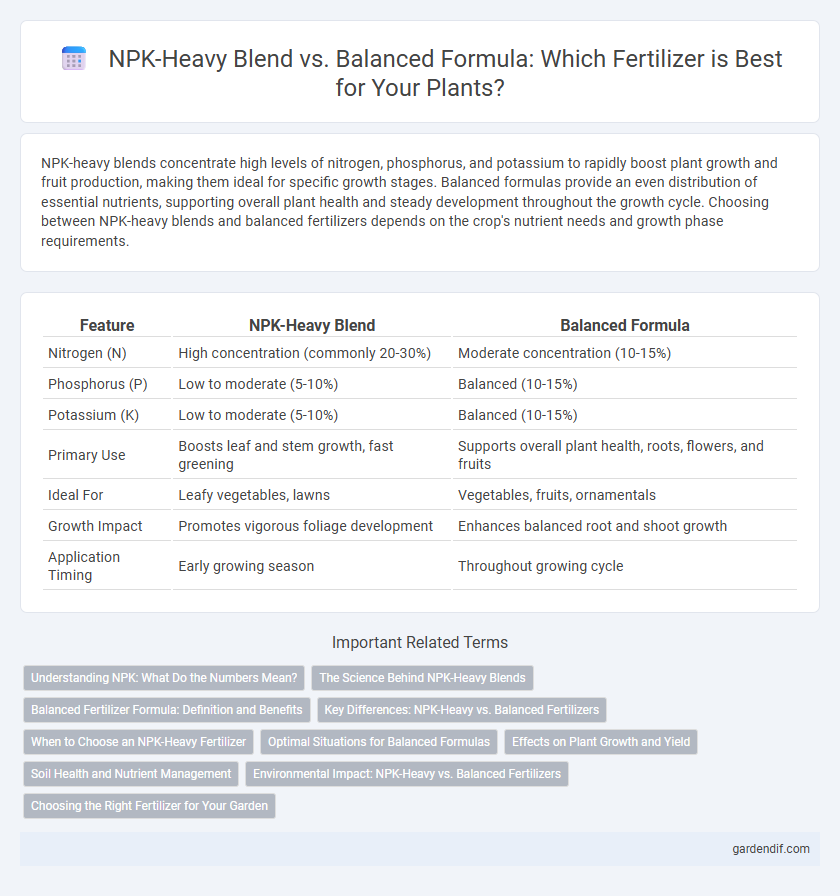
NPK-heavy blend vs balanced formula Illustration
NPK-heavy blends concentrate high levels of nitrogen, phosphorus, and potassium to rapidly boost plant growth and fruit production, making them ideal for specific growth stages. Balanced formulas provide an even distribution of essential nutrients, supporting overall plant health and steady development throughout the growth cycle. Choosing between NPK-heavy blends and balanced fertilizers depends on the crop's nutrient needs and growth phase requirements.
Table of Comparison
| Feature | NPK-Heavy Blend | Balanced Formula |
|---|---|---|
| Nitrogen (N) | High concentration (commonly 20-30%) | Moderate concentration (10-15%) |
| Phosphorus (P) | Low to moderate (5-10%) | Balanced (10-15%) |
| Potassium (K) | Low to moderate (5-10%) | Balanced (10-15%) |
| Primary Use | Boosts leaf and stem growth, fast greening | Supports overall plant health, roots, flowers, and fruits |
| Ideal For | Leafy vegetables, lawns | Vegetables, fruits, ornamentals |
| Growth Impact | Promotes vigorous foliage development | Enhances balanced root and shoot growth |
| Application Timing | Early growing season | Throughout growing cycle |
Understanding NPK: What Do the Numbers Mean?
NPK represents the ratio of nitrogen (N), phosphorus (P), and potassium (K) in fertilizers, essential nutrients for plant growth. NPK-heavy blends contain higher concentrations of one or two nutrients tailored for specific plant needs, such as nitrogen for leafy growth or phosphorus for root development. Balanced formulas provide equal or near-equal proportions of N, P, and K, supporting overall plant health and promoting steady growth in diverse gardening applications.
The Science Behind NPK-Heavy Blends
NPK-heavy blends emphasize higher concentrations of nitrogen (N), phosphorus (P), and potassium (K) to rapidly promote specific plant growth stages such as foliage development, root establishment, or fruiting. The science behind these blends leverages targeted nutrient ratios tailored to soil tests and crop requirements, optimizing nutrient uptake efficiency and minimizing waste. Compared to balanced formulas, NPK-heavy blends can address deficiencies more aggressively, enhancing yield and plant vigor under precise agronomic conditions.
Balanced Fertilizer Formula: Definition and Benefits
Balanced fertilizer formula contains equal or near-equal proportions of nitrogen (N), phosphorus (P), and potassium (K), ensuring comprehensive nutrient supply for plant growth. This formula supports root development, flowering, and overall plant health by addressing the varied nutritional needs of different crops simultaneously. Using balanced fertilizer reduces the risk of nutrient deficiencies and promotes sustainable soil fertility compared to NPK-heavy blends that focus on one or two primary nutrients.
Key Differences: NPK-Heavy vs. Balanced Fertilizers
NPK-heavy fertilizers contain disproportionately high levels of nitrogen, phosphorus, or potassium, targeting specific nutrient deficiencies and promoting rapid growth or fruiting. Balanced fertilizers provide equal or near-equal ratios of NPK, supporting overall plant health and steady development. Selecting between NPK-heavy and balanced formulas depends on soil nutrient analysis and crop-specific requirements for optimized yield.
When to Choose an NPK-Heavy Fertilizer
Choose an NPK-heavy fertilizer when rapid nutrient uptake is essential for crops with high nitrogen, phosphorus, and potassium demands, such as during critical growth stages like flowering and fruiting. These fertilizers provide concentrated nutrient ratios that support vigorous growth, fruit development, and root strengthening, especially in nutrient-depleted soils. Using an NPK-heavy blend helps optimize yield in intensive agricultural systems and for plants requiring targeted feeding.
Optimal Situations for Balanced Formulas
Balanced fertilizer formulas with equal or near-equal proportions of nitrogen (N), phosphorus (P), and potassium (K) are optimal for crops requiring steady nutrient supply throughout all growth stages. These formulas promote uniform development of roots, foliage, and fruit, making them ideal for mixed vegetable gardens, lawns, and flowering plants. Balanced blends support soil health by minimizing nutrient imbalances and enhancing long-term fertility.
Effects on Plant Growth and Yield
NPK-heavy blend fertilizers, rich in nitrogen, phosphorus, and potassium, promote rapid vegetative growth and increased fruit or flower yield, making them ideal for fast-growing crops requiring high nutrient intake. Balanced formula fertilizers provide a steady supply of essential nutrients in equal proportions, supporting overall plant health, root development, and moderate but consistent growth. Choosing between NPK-heavy and balanced formulas depends on specific crop needs, soil nutrient levels, and desired yield outcomes.
Soil Health and Nutrient Management
NPK-heavy blends concentrate on specific nutrient ratios, often leading to rapid nutrient availability but risking soil nutrient imbalance and depletion over time. Balanced formulas provide a more comprehensive nutrient profile, promoting sustained soil health by improving microbial activity and maintaining nutrient equilibrium. Effective nutrient management hinges on matching fertilizer compositions to soil tests, ensuring optimal crop nutrition and long-term soil fertility.
Environmental Impact: NPK-Heavy vs. Balanced Fertilizers
NPK-heavy blend fertilizers often contain higher concentrations of nitrogen, phosphorus, and potassium, which can lead to nutrient runoff and water pollution, negatively impacting aquatic ecosystems. Balanced formula fertilizers distribute nutrients more evenly, reducing the risk of soil nutrient imbalances and minimizing environmental degradation. Choosing balanced fertilizers supports sustainable agriculture by promoting soil health and lowering the potential for harmful environmental effects.
Choosing the Right Fertilizer for Your Garden
NPK-heavy blends, rich in nitrogen, phosphorus, or potassium, target specific nutrient deficiencies for plants needing concentrated support, such as leafy greens or flowering crops. Balanced formula fertilizers provide equal proportions of N, P, and K, promoting overall plant health and steady growth in diverse garden settings. Assessing soil nutrient levels and plant requirements ensures optimal fertilizer selection, enhancing productivity and sustainability.
NPK-heavy blend vs balanced formula Infographic

 gardendif.com
gardendif.com